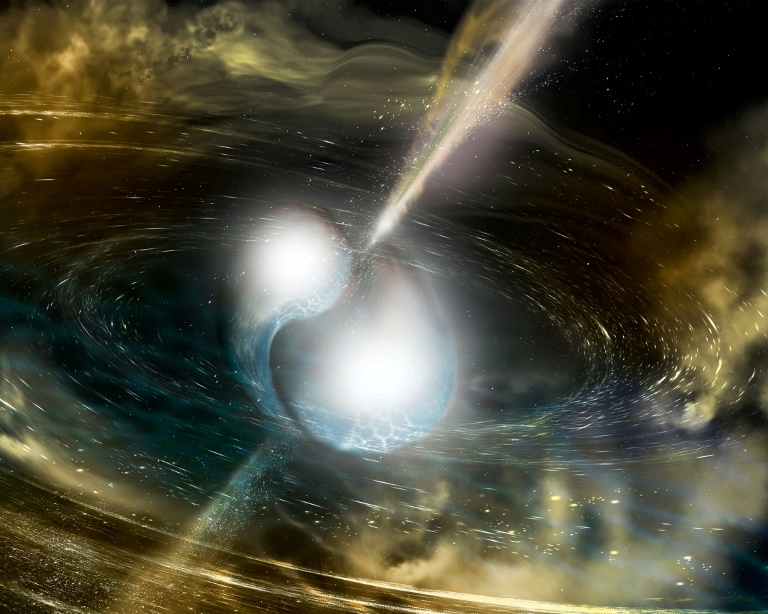Science
Astronomers Uncover Fast X-Ray Transient from Nearby Supernova

A recent discovery has unveiled the origins of a fast X-ray transient (FXT) linked to a supernova, highlighting a significant breakthrough in astrophysics. This cosmic phenomenon, known as EP 250108a, is the closest FXT associated with a supernova ever observed, located approximately 2.8 billion light-years away in the constellation Eridanus.
This collaborative research, led by teams from Northwestern University and the University of Leicester, reveals that the FXT was produced by a geyser of high-energy particles trapped within the outer layers of a massive star. The study sheds light on the elusive nature of FXTs, which have perplexed astronomers since their detection began in the 1970s.
By utilizing a range of telescopes, both terrestrial and space-based, the researchers captured the transient’s signals across various wavelengths, providing a comprehensive view of the event. The newly launched Einstein Probe, deployed by the Chinese Academy of Sciences in partnership with the European Space Agency and the Max Planck Institute for Extraterrestrial Physics, played a critical role in this research. Since its launch in January 2024, the probe has successfully identified the FXT associated with the supernova, offering unprecedented observational opportunities.
The FXT EP 250108a emerged from a supernova designated as SN 2025kg, also referred to as “the kangaroo.” This supernova exhibited an increase in brightness over several weeks before beginning to fade. Detailed observations confirmed that “the kangaroo” is classified as a broad-lined Type Ic supernova, which is typically linked to highly energetic events like gamma-ray bursts (GRBs).
In this particular case, however, no evidence of a GRB was detected. The research team postulated that EP 250108a represents a “failed” GRB, where jets produced during the explosion did not penetrate the star’s outer layer but remained confined within, resulting in the detectable FXT.
The study utilized multiple facilities, including the FLAMINGO-2 spectrograph at the Gemini South telescope and the Gemini Multi-Object Spectrograph at the Gemini North telescope, to gather near-infrared and optical data. Additional observations were made at the W.M. Keck Observatory in Hawaii, the MMT Observatory in Arizona, and the James Webb Space Telescope.
Data from these observations allowed scientists to estimate that the progenitor star responsible for EP 250108a had a mass between 15 to 30 times that of the sun. The collaborative nature of this research emphasizes the importance of global scientific partnerships in advancing our understanding of cosmic events.
Two companion studies detailing various aspects of this discovery have been accepted for publication in The Astrophysical Journal Letters. The first paper, titled “The kangaroo’s first hop: the early fast cooling phase of EP 250108a/SN 2025kg,” explores the initial cooling phase of the event. The second paper, “EP 250108a/SN 2025kg: Observations of the most nearby Broad-Line Type Ic Supernova following an Einstein Probe Fast X-ray Transient,” delves into the observational data collected during this groundbreaking study.
This discovery not only enhances our understanding of FXTs but also establishes a potential link between GRB-supernovae and FXT-supernovae. By clarifying the mechanisms behind these cosmic explosions, researchers hope to unlock further mysteries about the life cycle of massive stars and their explosive deaths.
-

 Politics4 weeks ago
Politics4 weeks agoSecwepemc First Nation Seeks Aboriginal Title Over Kamloops Area
-

 World5 months ago
World5 months agoScientists Unearth Ancient Antarctic Ice to Unlock Climate Secrets
-

 Entertainment5 months ago
Entertainment5 months agoTrump and McCormick to Announce $70 Billion Energy Investments
-

 Science5 months ago
Science5 months agoFour Astronauts Return to Earth After International Space Station Mission
-

 Lifestyle5 months ago
Lifestyle5 months agoTransLink Launches Food Truck Program to Boost Revenue in Vancouver
-

 Technology3 months ago
Technology3 months agoApple Notes Enhances Functionality with Markdown Support in macOS 26
-

 Lifestyle3 months ago
Lifestyle3 months agoManitoba’s Burger Champion Shines Again Amid Dining Innovations
-

 Top Stories2 months ago
Top Stories2 months agoUrgent Update: Fatal Crash on Highway 99 Claims Life of Pitt Meadows Man
-

 Politics4 months ago
Politics4 months agoUkrainian Tennis Star Elina Svitolina Faces Death Threats Online
-

 Sports5 months ago
Sports5 months agoSearch Underway for Missing Hunter Amid Hokkaido Bear Emergency
-

 Politics5 months ago
Politics5 months agoCarney Engages First Nations Leaders at Development Law Summit
-

 Technology5 months ago
Technology5 months agoFrosthaven Launches Early Access on July 31, 2025





















